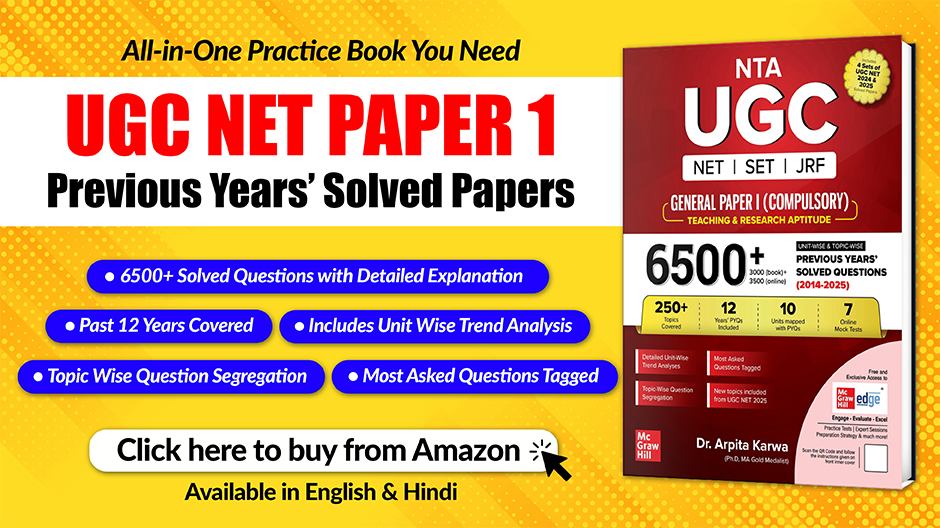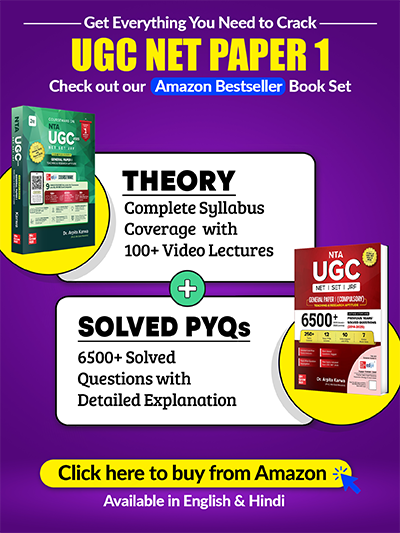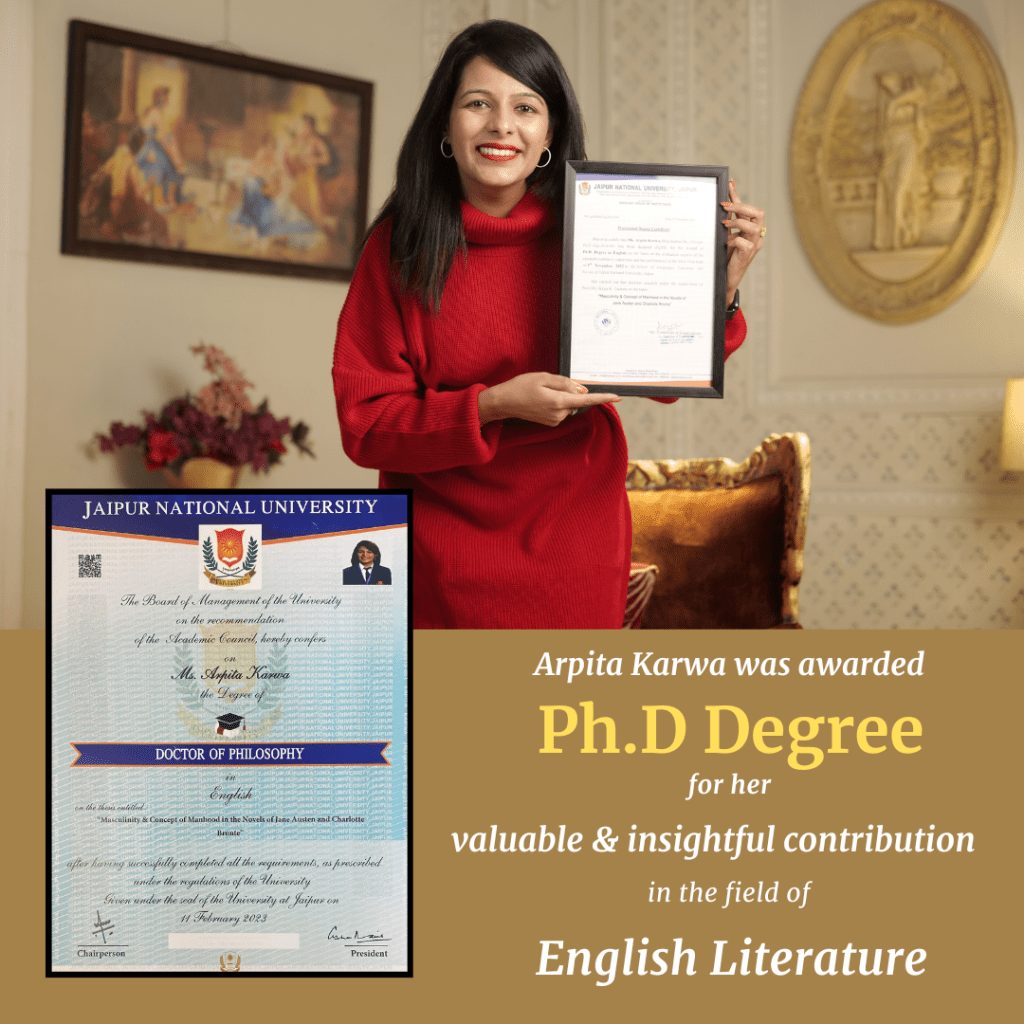December 2015 : Paper 2
October 19, 2022 2025-10-13 13:05December 2015 : Paper 2
December 2015 : Paper 2
Q.1) Who, among the following, advanced the theory that the mind is a tabula rasa at birth, and acquires all ideas by experience?
[1] John Locke
[2] John Wesley
[3] Isaac Watts
[4] Denis Diderot
Answer: 1
Q.2) Which of the following authors wrote Studies in the History of the Renaissance?
[1] Walter Pater
[2] Oscar Wilde
[3] Thomas Carlyle
[4] John Ruskin
Answer: 1
Q.3) Whom does Harriet Smith finally marry in one of Jane Austen’s novels?
[1] Knightley
[2] Darcy
[3] Collins
[4] Mr. Martin
Answer: 4
Q.4) A poet once referred to an old man as “A tattered coat upon a stick”. That is an example of ………………
[1] Metonymy
[2] Sarcasm
[3] Simile
[4] Metaphor
Answer: 4
Q.5) Which of these is NOT a pastoral elegy?
[1] Lycidas
[2] In Memoriam
[3] Thyrsis
[4] Adonais
Answer: 2
Q.6) In Beckett’s Waiting for Godot the characters often use dislocated, repetitious and cliched speech primarily to:
[1] illustrate the essentially illogical, purposeless nature of the human condition
[2] re-create the workings of the subconscious
[3] mock the exaggerated dignity and wisdom of modern, self-professed intellectuals
[4] reinforce the comic action of farcical plots
Answer: 1
Q.7) Which of the following sixteenth-century poets was NOT a courtier?
[1] George Puttenham
[2] Philip Sidney
[3] Walter Raleigh
[4] Thomas Wyatt
Answer: *
Q.8) Patrick White published two novels in the 1950s giving the eras of pioneering and exploration in Australian history an epic, ironic and psychological dimension. The novels are:
(a) A Fringe of Leaves
(b) The Tree of Man
(c) Voss
(d) The Aunt’s Story
The right combination according to the code is:
[1] (a) and (b)
[2] (b) and (c)
[3] (c) and (a)
[4] (c) and (d)
Answer: 2
Q.9) In which of the following works did Bakhtin propose his widely cited concept of the ‘Carnivalesque’?
[1] “Discourse in the novel”
[2] Dialogic Imagination
[3] Rabelais and his world
[4] “Forms of Time and of the Chronotope in the Novel”
Answer: 3
Q.10) Match the columns:
(Author)
(a) Sebastian Faulks
(b) Peter Ackroyd
(c) Ian McEwan
(d) David Lodge
(Text)
(i) Amsterdam
(ii) Changing Places
(iii) Hawksmoor
(iv) Birdsong
[1] (a)-(i), (b)-(ii), (c)-(iii), (d)-(iv)
[2] (a)-(ii), (b)-(iii), (c)-(i), (d)-(iv)
[3] (a)-(iv), (b)-(iii), (c)-(i), (d)-(ii)
[4] (a)-(iii), (b)-(iv), (c)-(ii), (d)-(i)
Answer: 3
Q.11) In New Criticism, the key term ‘tension’ is associated with:
[1] Cleanth Brooks
[2] John Crow Ransom
[3] Austin Warren
[4] Allen Tate
Answer: 4
Q.12) While compiling what sort of book did Samuel Richardson conceive of the idea for his Pamela or Virtue Rewarded?
[1] an account of the plague in London
[2] an instruction manual for manners
[3] a book of devotion
[4] a book of model letters
Answer: 4
Q.13) Who among the war Poets gained notoriety in 1917, when disenchanted with the way the war was being conducted he drafted his letter of “wilful defiance of the military authority” which captured attention in the House of Commons, and was forcibly admitted to the war hospital at Craiglockhart, primarily to avoid his being court-martialled?
[1] Rupert Brooke
[2] Siegfried Sassoon
[3] Wilfred Owen
[4] Isaac Rosenberg
Answer: 2
Q.14) If you cannot understand an argument and remark, “It’s Greek to me”, you are quoting ……………
[1] John Milton
[2] Samuel Johnson
[3] William Shakespeare
[4] John Donne
Answer: 3
Q.15) Which of the following works did Walter Scott compile?
[1] The Lay of the Last Minstrel
[2] Marmion
[3] Ivanhoe
[4] The Minstrelsy of Scottish Border
Answer: 4
Q.16) Which of the following is NOT written by Wole Soyinka?
[1] Home and Exile
[2] Kongi’s Harvest
[3] The interpreters
[4] The Swamp Dwellers
Answer: 1
Q.17) In the Defense of Poesy Sidney says: “Now as in geometry the oblique must be known as well as right and in arithmetic, the odd as well as the even, so in the actions of our life who seeth not the filthiness of evil wanteth a great foil to perceive the beauty of virtue”. Which of the following forms of poesy offers a foil that helps us perceive the beauty of virtue?
[1] Pastorals
[2] Parody
[3] Comedy
[4] Tragedy
Answer: 3
Q.18) John Dryden described a major English poet as “a rough diamond, and must first be polished ere he shines …..” Identify him:
[1] Geoffrey Chaucer
[2] John Gower
[3] George Herbert
[4] Robert Herrick
Answer: 1
Q.19) In a remarkably proleptic insight, a critic wrote the following, anticipating Benedict Anderson’s definition of the nation as “an imagined political community”:
“Most novels are in some sense knowable communities. It is part of a traditional method — an underlying stance and approach — that a novelist offers to show people and their relationships in essentially knowable and communicable ways”.
Name the critic and the reference
[1] Van Wyck Brooks, The writer in America
[2] Raymond Williams, The country and the city
[3] Joseph Wood Krutch, The Modern Temper
[4] T.S. Eliot, Notes Towards a Definition of culture
Answer: 2
Q.20) “Fair is my love, and cruel as she’s fair; Her brow-shades frown, although her eyes are sunny”.
The above lines are characterized by:
[1] circumlocution
[2] antithesis
[3] anticlimax
[4] bathos
Answer: 2
Q.21) In his “Epistle to Dr. Arbuthnot” Pope tells us that as a poet he had benefited from “This saving counsel, ‘keep your piece nine years’” – which enjoins on writer’s patience and great care before they rush to print. Whose “counsel” is Pope referring to?
[1] Longinus’s in On the Sublime
[2] Horace’s in Ars Poetica
[3] Quintilian’s Institutio Oratoria
[4] Aristotle’s Poetics
Answer: 2
Q.22) An English architect and stage-designer – Beginning 1605, joined Jacobean court to design masques — contributed significantly to the spectacular theatre which succeeded the commonwealth after his death – the first designer to use revolving screens to indicate scene-changes on the English stage.
Identify this artist/designer.
[1] Henry Irving
[2] Inigo Jones
[3] Henry Arthur Jones
[4] William Inge
Answer: 2
Q.23) …………… may be defined as any departure from the rules of pronunciation or diction, for the sake of rhyme or metre, or an unjustifiable departure from fact.
[1] Poetic license
[2] Poetic justice
[3] Poetic deviance
[4] Poetic diction
Answer: 1
Q.24) That Humanities and the sciences were in fact “two cultures” was suggested by …………..
[1] Aldous Huxley in his oxford lectures on poetry
[2] W.H. Auden in his oxford lectures on poetry
[3] F.R. Leavis in his book, The Great Tradition
[4] C.P. Snow in his Rede lecture
Answer: 4
Q.25) Chaucer satirizes the Monk because the Monk:
[1] is too concerned with courtesy and matters of etiquette
[2] cheats the poor peasants by selling them false religious relics
[3] courts favour of wealthy people but spends no time with poor people
[4] spends too much time hunting and too little time on religious duty
Answer: 4
Q.26) Divided into three sections this ground-breaking work published in 1953 uses as the frame of the spiritual and moral awakening of a fourteen-year-old during a Saturday night service in a Harlem church. Identify the work.
[1] Zora Neale Hurston’s Their Eyes Are Watching God
[2] James Baldwin’s Go Tell it on the Mountain
[3] Toni Morrison’s Song of Solomon
[4] Richard Wright’s Native Son
Answer: 2
Q.27) Chartism, a political movement that took its name from the People’s Charter had six points. Identify the one point on the following list that was NOT Chartist:
(a) universal manhood suffrage
(b) equal electoral districts
(c) comprehensive insurance scheme for labour
(d) vote by secret ballot
(e) payment of MPs
(f) no property qualifications for MPs
(g) Annual parliaments
[1] (e)
[2] (g)
[3] (c)
[4] (d)
Answer: 3
Q.28) These beauteous forms,
Through a long absence, have been to me
As is a landscape to a blind man’s eye…
(“Tintern Abbey Lines”)
Which of the following rhetorical terms best suits these lines?
[1] Apostrophe
[2] Litotes
[3] Hyperbole
[4] Catachresis
Answer: 4
Q.29) The ‘monster’ in Frankenstein is NOT responsible for the death of:
[1] Clerval
[2] Justine
[3] Elizabeth
[4] Alphonse Frankenstein
Answer: 4
Q.30) Which of the following plays of William Shakespeare is NOT directly referred to in T.S. Eliot’s The Waste Land?
[1] Hamlet
[2] King Lear
[3] Coriolanus
[4] The Tempest
Answer: 2
Q.31) Identify the group below which is known as the “Sons of Ben”.
[1] Noel Coward, E.G. Craig, William Macready, Matheson, Lang
[2] John Dryden, the Earl of Rochester, Samuel Butler
[3] William Cartwright, Richard Corbett, Thomas Randolph
[4] William Holman hunt, John E. Millais, D.G. Rossetti, William Morris
Answer: 3
Q.32) Christopher Marlowe was one of the first major writers to affirm what can be identified as a clearly homosexual sensibility. Which drama of his deals with it?
[1] Edward II
[2] The Jew of Malta
[3] Doctor Faustus
[4] Dido, Queen of Carthage
Answer: 1
Q.33) “When true silence falls we are still left with echo but are nearer nakedness. One way of looking at speech is to say that it is a constant stratagem to cover nakedness”.
Identify the playwright who underlines the significance of silence thus.
[1] Samuel Beckett
[2] Harold Pinter
[3] Luigi Pirandello
[4] Joe Orton
Answer: 2
Q.34) The determining feature of syllabic verse is neither ……………. nor …………… but the number of syllables in a line.
[1] number, numbers
[2] sounds, silences
[3] stress, quantity
[4] gists, piths
Answer: 3
Q.35) In Robert Browning’s dramatic monologue, which painter does Andrea del Sarto compare himself to? What does he find lacking in his own work in comparison?
[1] Fra Lippo Lippi – humour
[2] Raphael – Soul
[3] Leonardo da Vinci – Verisimilitude
[4] Botticelli – liveliness
Answer: 2
Q.36) In which of the following does Robert Southey detail the Indian superstitions as an idolatry to be suppressed by a civilizing protestant form of colonialism?
[1] Thalaba
[2] The Curse of Kehama
[3] “Pitying the wolves”
[4] Country Horrors!
Answer: 2
Q.37) The following is the classic ending of a celebrated novella in English:
“I kept on creeping just the same, but I looked at him over my shoulder. I’ve got out at last’, said I, “in spite of you and Jane. And I’ve pulled off most of the papers, so you can’t put me back !“
Now why should that man have fainted? But he did, and right across my path by the wall, so that I had to creep over him every time !“
[1] Yellow Woman (Leslie Mormon Silko)
[2] The Yellow Wallpaper (Charlotte P.Gilman)
[3] Johnny Panic and the Bible of Dreams (Sylvia Plath)
[4] Where Are You Going, Where Have You Been? Joyce C. Oates)
Answer: 2
Q.38) Harriet B. Stowe had wanted to write a work based on the life of an Afro-American writer which was later published as:
[1] Uncle Tom’s Cabin
[2] Incidents in the Life of a Slave Girl
[3] Cry, The Beloved Country
[4] Narrative of the Life of Frederick Douglass
Answer: 2
Q.39) Samuel Johnson’s “Dissertation upon Poetry” is part of which of his following works?
[1] the final section of his preface to Shakespeare
[2] a chapter of his novel Rasselais
[3] the epilogue of his Lives of Poets
[4] one of his Rambler essays
Answer: 2
Q.40) A new series called “New Accents” was launched by Methuen in 1977. The first title to be published in the series was:
[1] Deconstruction: Theory and Practice
[2] Formalism and Marxism
[3] Structuralism and Semiotics
[4] Making and Difference: Feminist Literary criticism
Answer: 3
Q.41) “Humble and rustic life was generally chosen, because, in that condition, the essential passions of the heart find a better soil in which they can attain their maturity, are less under restraint, and speak a plainer and more emphatic language… The language, too, of these men has been adopted… because such men hourly communicate with the best objects from which the best part of language is originally derived”.
Which of the following groups of the author’s poems in the Lyrical Ballads (1800) contradict this statement in the “Preface to the Lyrical Ballads”, as pointed out by S.T. Coleridge?
[1] “Ode on the Intimations of Immortality”, Prelude.
[2] The Tasks, Seasons.
[3] “Michael”, “Ruth”, “The Brothers”.
[4] “Elegy Written in a country churchyard”, “Ode on the Popular Superstitions of the Highlands”.
Answer: 3
Q.42) A remarkable novelist of the English Modernist phase who wrote a short book on what the novel is (and why it matters) remarked, “Oh dear, yes – the novel tells a story”. Identify the novelist:
[1] Virginia Woolf
[2] James Joyce
[3] E.M. Forster
[4] DII. Lawrence
Answer: 3
Q.43) What is the name of the angel, who, of those who owed allegiance to Satan, dared to protest against his impious doctrine and left his company to return to God (Paradise Lost, Book V)?
[1] Michael
[2] Abdiel
[3] Uriel
[4] Gabriel
Answer: 2
Q.44) Which of the following is NOT a school associated with Romantic period in English literature?
[1] The Cockney School
[2] The Fireside School
[3] The Lake School
[4] The Satanic School
Answer: 2
Q.45) The idea of “new ethnicities” in post-war Britain was advanced by …………..
[1] Donald Hall
[2] Stuart Hall
[3] Paul Gilroy
[4] Hanif Kureshi
Answer: 2
Q.46) Virginia Woolf’s To the Lighthouse begins in a piece of dialogue:
“Yes, of course, if it’s fine tomorrow”, said Mrs. Ramsay. “But you’ll have to be up with lark”, she added.
Present among the listeners of her remark is ……………
[1] her father
[2] her nephew
[3] her son
[4] her driver
Answer: 3
Q.47) Match the phrase with character
(a) “motiveless malignity”
(b) “Reason in Madness”
(c) “Supp’d full of horrors”
(d) “To be, or not to be”
(i) Macbeth
(ii) Hamlet
(iii) Lear
(iv) Iago
[1] (a)-(i), (b)-(iii), (c)-(ii), (d)-(iv)
[2] (a)-(iv), (b)-(ii), (c)-(iii), (d)-(i)
[3] (a)-(iv), (b)-(iii), (c)-(i), (d)-(ii)
[4] (a)-(iii), (b)-(i), (c)-(ii), (d)-(iv)
Answer: 3
Q.48) In Tristram Shandy the narrator’s presentation of his life and opinions is ………….
[1] linear
[2] digressive
[3] chronological
[4] rounded
Answer: 2
Q.49) The famous sonnet of John Milton beginning “When I consider how my light is spent…” ends with ……………
[1] Before me stares a wolfish eye, Behind me creeps a groan or sigh
[2] They also serve who only stand and wait
[3] And – which is more – you’ll be a Man, my son!
[4] And bless him for the sake of him that’s gone
Answer: 2
Q.50) Her vision was of several caves. She saw herself in one, and she was also outside it, watching its entrance, for Aziz to pass in. She failed to locate him. It was the doubt that had often visited her, but solid and attractive, like the hills. “I am not —“speech was more difficult than vision. “I am not quite sure”.
The above extract from A Passage to India is about Adela’s cave experience. Who is questioning Adela?
[1] Mrs. Moore
[2] Mr. McBryde
[3] Fielding
[4] Ronney Heaslop
Answer: 2
























